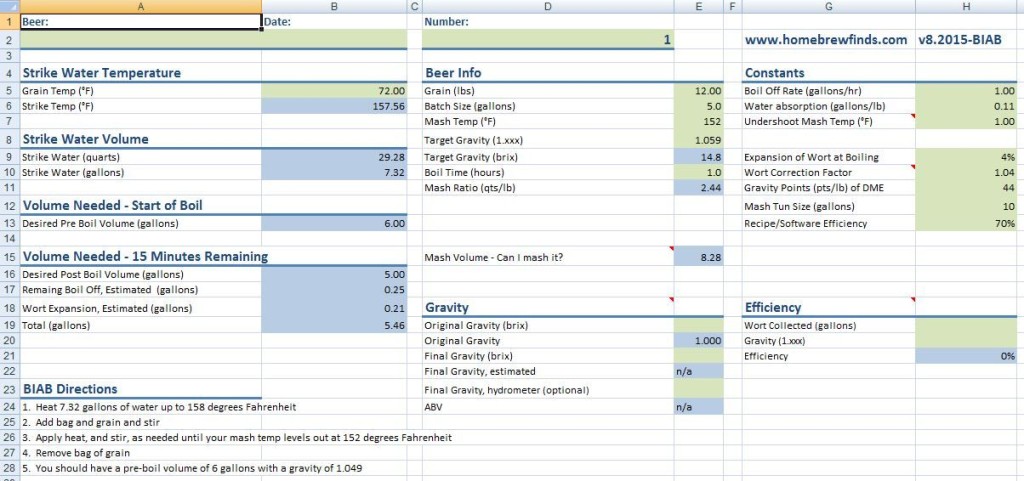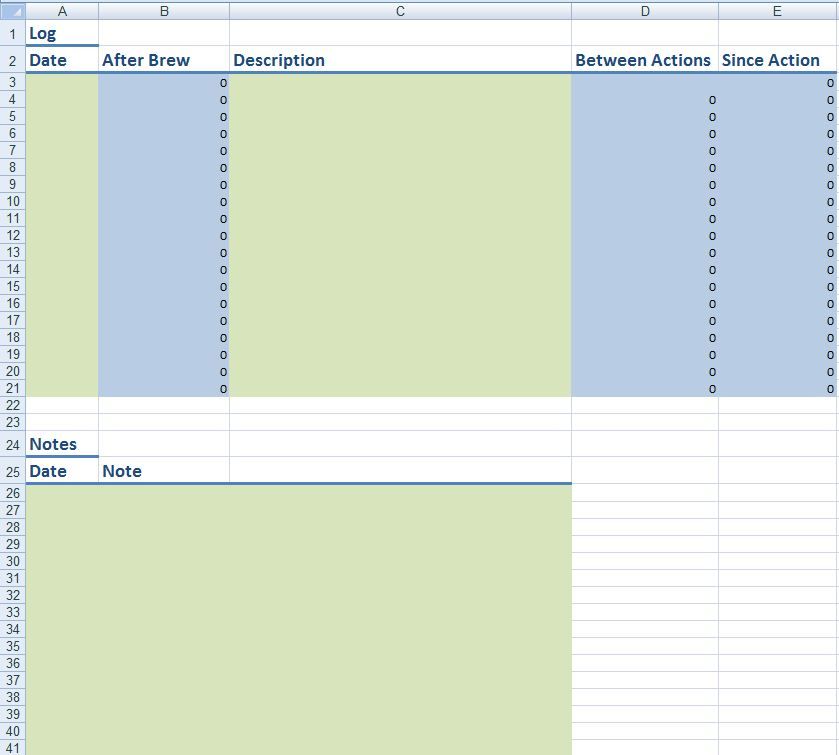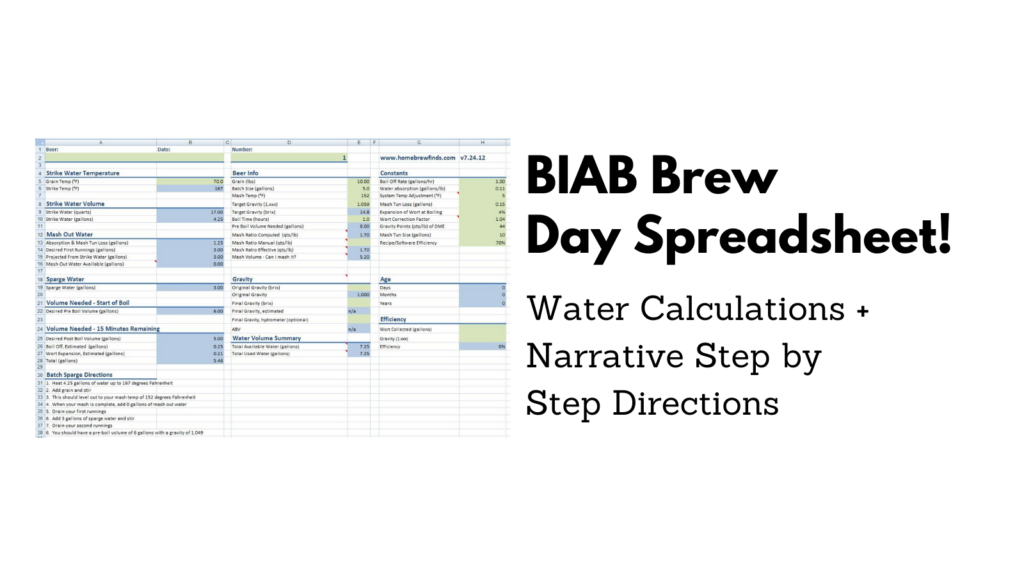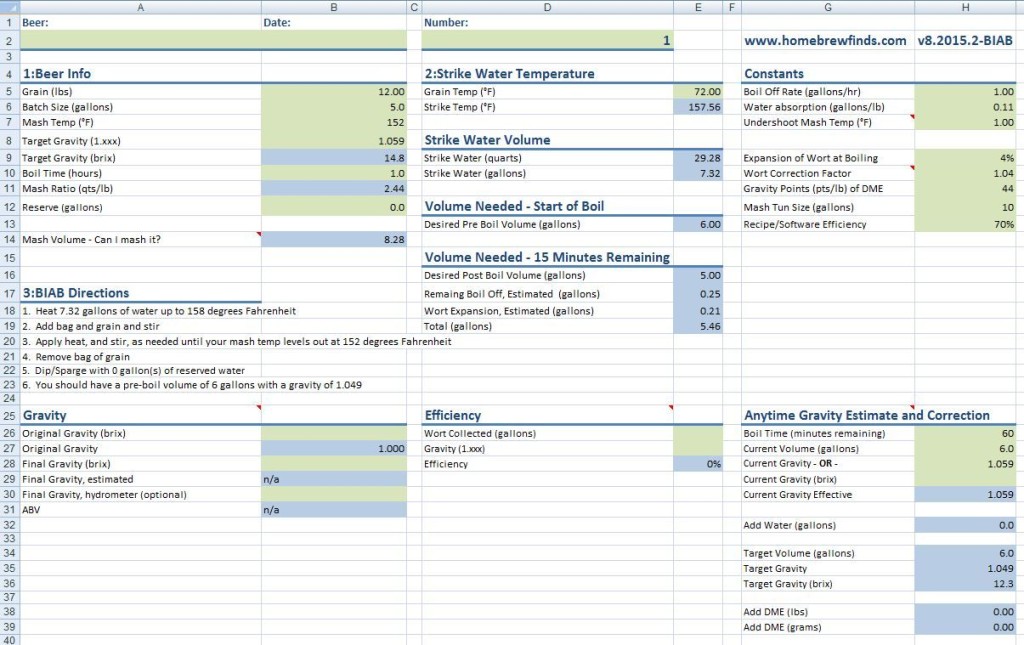
BIAB Brew Day Spreadsheet – Water Calculations + Narrative Step by Step Directions
Why BIAB?
Brew in a Bag (BIAB) is a quick, easy and economical way to brew all grain batches of beer. I released my brew day spreadsheet some time ago along with a version of that to be used for small batch beers. See below for links. Either of those could be modified to work with BIAB by changing variables, This version is specifically designed for full size BIAB batches.
Main Page (click to enlarge):
Related:
- BIAB Bags at MoreBeer
- Hands on Review: The Brew Bag – Purpose Made BIAB
- Search Amazon for “BIAB Bag”
- The Brew Bag – Purpose Made BIAB Bag
- Homebrewing Spreadsheets – a collection of brewing spreadsheets to make your brew day easier
Need More?
My brew day spreadsheet helps you calculate water volumes and temps and helps you do simple tracking.
If you’re looking for a powerful, full featured solution for building recipes, brew day tracking and loads more, consider Brewfather.
- Hands on Review: Brewfather App – Recipe Formulation, Calculators & Brew Day Tools
- Brewfather offers a free full feature trial. After the trial period, you’ll still have access via a limited, non-expiring account
How I Use Brew Day Spreadsheets
How do I use brew day spreadsheets? First, I do use recipe formulation software. Some of those programs have brew day components. I’ve just never gotten into using those features. For better or worse, I use a spreadsheet. I make a copy and name it using the batch number and beer name and then quickly plug in the basics. This creates a one sheet printable page that I can use on brew day. That gives me a single piece of paper with all of my numbers and a spot for brew day notes. Notes can go back into the spreadsheet for archival.
The Spreadsheet Layout
Color Coding: Green Cells are information that you can fill in and Blue/Light Gray Cells are calculated.
General Layout and Flow: Start with Beer Name, Brew Date, Batch Number and 1:Beer Info. Fill in current grain temp under 2:Strike Water Temperature and step by step directions are populated under 3:BIAB Directions. Constants on the right hand can be set once for your setup and adjusted as needed. The bottom section of this sheet contains three calculators explained below.
1:Beer Info: Basic information about your beer and mash profile.
“Reserve (gallons)” B12 Cell: Allows you to set aside a set number of gallons for sparge, dunking, topping off, etc. This is subtracted from the total strike water value. It is assumed that you will add or use this at some point.
“Mash Volume – Can I mash it?”: This field estimates total mash volume including grain and water. This is an estimate. The cell turns red if the projected volume of your mash exceeds the size of your mash tun. This is an adaptation of the formula found on the Green Bay Rackers Calculators Page.
2:Strike Water Temp: Fill in the Beer Info section and your Grain’s current Temperature (cell B5) and the spreadsheet calculates your strike water temperature (cell B6). Note that the temperature will be offset by the “Undershoot Mash Temp” (cell H7). Read the constants section for more info on that.
Strike Water Volume: Calculates the amount of water you will need in both quarts and gallons.
Volume Needed – Start of Boil and 15 Minutes Remaining: These sections list required water volume at two important times. The 15 minute calculation attempts to take into account expansion of wort at boiling. Take a measurement at 15 minutes and use this figure to correct a low volume.
Constants: The constants section has some variables that you can adjust based on your setup. For example, I’ve found that grain absorption for my crush is right around .11 gallons/lb. I think that will be close for you but you can tweak it here if you observe something different.
A note on “Undershoot Mash Temp” – This cell allows you to come in under your desired mash temp. Why would you want to do that? It’s easier to ramp up a degree or two vs cool down a degree or two. This number is subtracted from the calculated Strike Water Temperature recommendation (cell B6).
I suggest reviewing the Constants section to make adjustments for your setup.
3: BIAB Directions: These are narrative step-by-step directions that you can follow after you fill in Beer Info, Grain Temp and Constants. Note that you can use the table from the “Summary Tab” for on the go adjustments to the strike temp referenced in step 1.
Calculators – The bottom three sections of this tab are calculators. These calculators can pull from cells in the top portion of the tab, but they do not affect 3:BIAB Directions.
Gravity: This is an adaption of Sean Terrill’s Refractometer Calculator (used by permission). Thanks Sean for your excellent work on this!
Efficiency: This calculation uses your recipe software’s efficiency setting for a particular recipe along with target gravity to figure efficiency. That means no re-entering fermentables for every batch. I figure efficiency when going from the mash tun to the boil kettle. This is a calculator in the sense that it is standalone and has no bearing on other calculations or cells.
Anytime Gravity Estimate and Correction: Plug in volume, boil time and gravity figures at any time during your brew day and this calculator will suggest volume and gravity corrections. Accepts either gravity or Brix (if both are present the Brix value is used). If you are under volume, I would suggest correcting volume and then re-checking gravity. This calculator makes no attempt to correct volumes or gravities that are too high.
Summary Sheet (click to enlarge):
This is setup to print on a regular 8 1/2″ x 11″ sheet of paper and gives a rundown of essential brew day tasks and data. I use this print out on brew day.
Prepare: This is a simple to do checklist. You can modify this section as you see fit based on your procedure.
Water Volumes/Gravity: This projects the volume and gravity you should have at three stages (start of boil, 15 minutes remaining and end of boil). The last two columns (lb DME/pt and grams) are meant to allow you to easily correct your gravity at those stages. Each of those amounts should add 1 gravity point to your beer. Let’s say you’re three points down at the start of the boil. With the example in this graphic, you would add .42 lbs of DME to correct the gravity of the 6 gallon batch. Bam… that’s easy!
Hop/Adjunct Schedule: You can choose either grams or ounces. If you choose ounces it will also be converted to grams.
Strike Temp: This is a table version of the calculated strike temp found on the brew day sheet. The initial temperature can be changed. This changes subsequent values. If you’re using a summary printout, you can measure the temp of your grain and refer to this chart for the appropriate strike temp.
Log and Notes Sheet (click to enlarge):
Log: This section is meant to log actions taken on the beer (fermentation temp changes, dry hopping, oak additions, etc). It calculates the time that has elapsed since brew day, between actions and since the action took place.
Notes: Simple notes section.
Download
This is a Microsoft Excel Spreadsheet. I would suggest running this through your previous calculation methods to double check that all this makes sense for you and to verify constants. I don’t want you coming back to me and complaining the your double IPA is a Pale Ale because of me. 🙂
Homebrew Finds BIAB Spreadsheet
If you have a question or suggestion for the spreadsheet, send me an email
Need More?
My brew day spreadsheet helps you calculate water volumes and temps and helps you do simple tracking.
If you’re looking for a powerful, full featured solution for building recipes, brew day tracking and loads more, consider Brewfather.
- Hands on Review: Brewfather App – Recipe Formulation, Calculators & Brew Day Tools
- Brewfather offers a free full feature trial. After the trial period, you’ll still have access via a limited, non-expiring account
Related:
- BIAB Bags at MoreBeer
- Hands on Review: The Brew Bag – Purpose Made BIAB
- Search Amazon for “BIAB Bag”
- The Brew Bag – Purpose Made BIAB Bag
- Homebrewing Spreadsheets – a collection of brewing spreadsheets to make your brew day easier
More BIAB-Related!
- BIAB Brew Day Spreadsheet – easy water and temp calculations
- The Brew Bag – Purpose Made BIAB
- Get a Bag! Search Amazon for “BIAB Bag”
- Brew In a Bag: Brew fantastic craft beers at home using the All Grain brew in a bag method
- Small Batch, All Grain Stove Top Brewing Using BIAB
- Should You Buy a Homebrew Grain Mill?
- All Grain Tips & Gear
- BIAB: Brew in a Bag – Easy All Grain Homebrew! – Gear, Resources & Reviews
This post may contain affiliate links. We may make a commission when you use our links. This will never cost you extra. Thank you for supporting Homebrew Finds!
greatdealsMore Homebrew Finds!
- Last 50 Finds!
- Top Deals – a curated list of the best deals
- Homebrew Reviews – one of the largest libraries of homebrew reviews in existence!
- Our Top Posts – tips, how-tos, resources posts and more
- Let’s be Friends!
Recent Deals!
10 Most Recent Homebrew Resource Posts & How-To’s!
We are Homebrew Review HQ! Our 10 Most Recent Reviews
Always use caution when dealing with hot liquids and electricity. Make sure the components you use are compatible and rated for your intended application. Contact manufacturer with questions about suitability or a specific application. Always read and follow manufacturer directions.
Homebrew Finds makes no representations as to accuracy, completeness, currentness, suitability, or validity of any information in this article and will not be liable for any errors, or omissions in this information or any losses, injuries, or damages arising from its display or use. All information is provided on an as-is basis. To use Homebrew Finds you must be 21 years or older
This is a Top Post! See: All Top Posts – tag:lnksfxd toppost:biabspreadsheet rs:7 tag:tpr










Do you do any water adjustments to account for pH? I have found the pH levels of my mash get high when doing BIAB.
Hey Nick! I don’t always do that, but I certainly have. How do you usually figure water adjustments?
I’ve used bru’n water spreadsheet in the past, with mixed results.
Awesome. Would be great if this were available in metric as well.
Nice job and thanks for sharing the spreadsheet. One question I have is about the water absorption constant. This is just for the grains, correct? I was wondering how you could incorporate absorption for hoppier brews, such as a Pliny the Elder clone or other double IPAs with massive amounts of hops?
The absorption is just for the grain. It doesn’t take into account trub loss or hop absorption. Good additions for a v2.
I regularly hit 72-75% efficiency with my BIAB set up. Try:
– a finer crush (just a bit.)
– a better bag (unsolicited plug for Brew Bag for cooler or kettle)
– 90 min mash.
– 75 min boil (only on some styles.)
What is your typical efficiency for BIAB? Do you crush finer for BIAB? I ask because I did one BIAB a few months back and had a efficiency of about 65% based on my normal all grain set up and my normal crush.
Thank you!
About 65% for me. I haven’t spent a lot of time trying to better that.
Thank you. Just wanting to make sure 65% was reasonable.